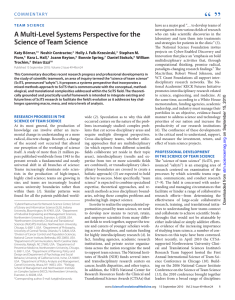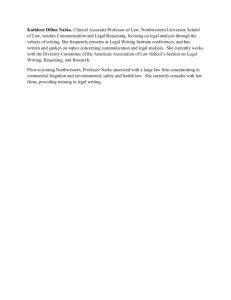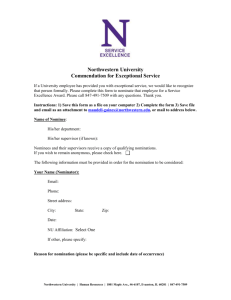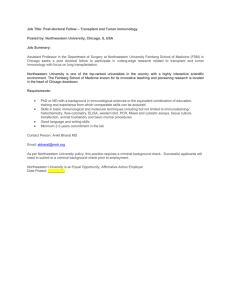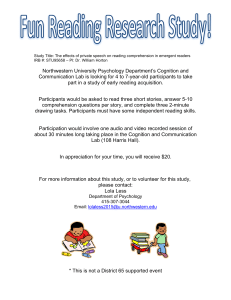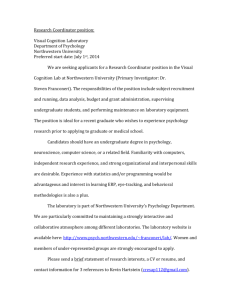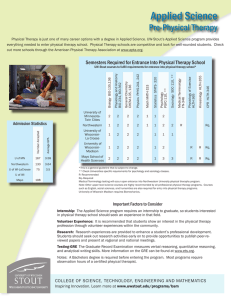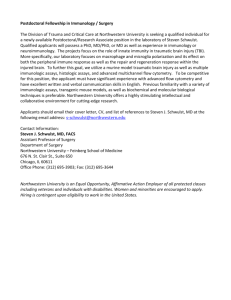Advancing the Science of Team Science
advertisement
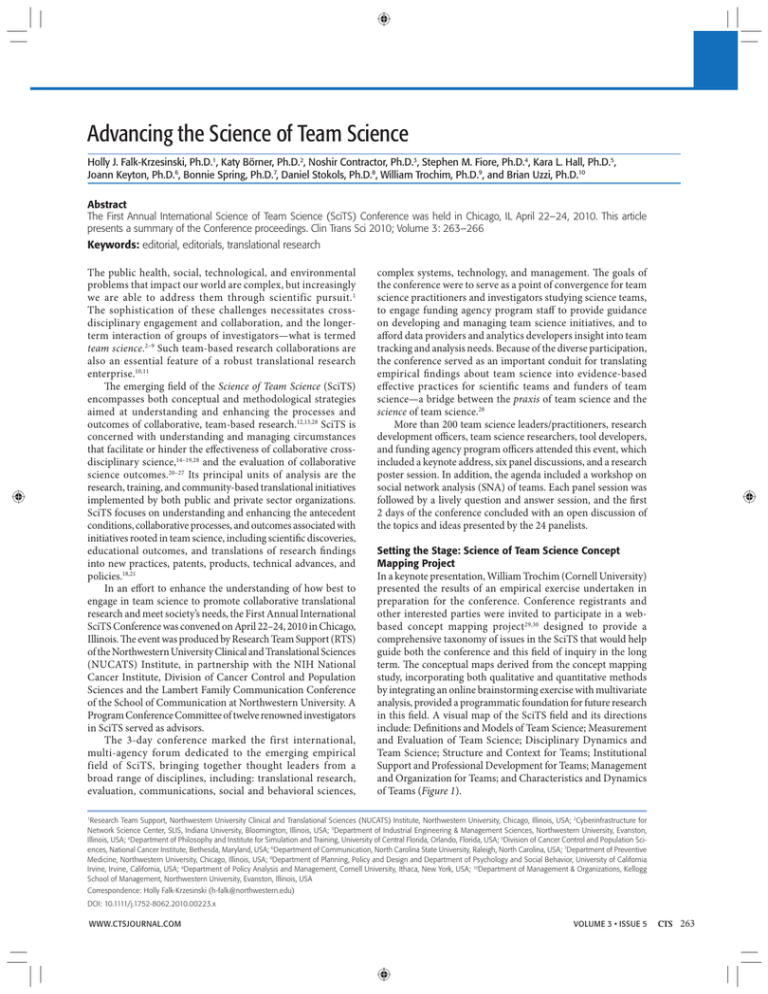
Advancing the Science of Team Science Holly J. Falk-Krzesinski, Ph.D.1, Katy Börner, Ph.D.2, Noshir Contractor, Ph.D.3, Stephen M. Fiore, Ph.D.4, Kara L. Hall, Ph.D.5, Joann Keyton, Ph.D.6, Bonnie Spring, Ph.D.7, Daniel Stokols, Ph.D.8, William Trochim, Ph.D.9, and Brian Uzzi, Ph.D.10 Abstract The First Annual International Science of Team Science (SciTS) Conference was held in Chicago, IL April 22–24, 2010. This article presents a summary of the Conference proceedings. Clin Trans Sci 2010; Volume 3: 263–266 Keywords: editorial, editorials, translational research The public health, social, technological, and environmental problems that impact our world are complex, but increasingly we are able to address them through scientific pursuit. 1 The sophistication of these challenges necessitates crossdisciplinary engagement and collaboration, and the longerterm interaction of groups of investigators—what is termed team science.2–9 Such team-based research collaborations are also an essential feature of a robust translational research enterprise.10,11 The emerging field of the Science of Team Science (SciTS) encompasses both conceptual and methodological strategies aimed at understanding and enhancing the processes and outcomes of collaborative, team-based research.12,13,28 SciTS is concerned with understanding and managing circumstances that facilitate or hinder the effectiveness of collaborative crossdisciplinary science,14–19,28 and the evaluation of collaborative science outcomes.20–27 Its principal units of analysis are the research, training, and community-based translational initiatives implemented by both public and private sector organizations. SciTS focuses on understanding and enhancing the antecedent conditions, collaborative processes, and outcomes associated with initiatives rooted in team science, including scientific discoveries, educational outcomes, and translations of research findings into new practices, patents, products, technical advances, and policies.18,21 In an effort to enhance the understanding of how best to engage in team science to promote collaborative translational research and meet society’s needs, the First Annual International SciTS Conference was convened on April 22–24, 2010 in Chicago, Illinois. The event was produced by Research Team Support (RTS) of the Northwestern University Clinical and Translational Sciences (NUCATS) Institute, in partnership with the NIH National Cancer Institute, Division of Cancer Control and Population Sciences and the Lambert Family Communication Conference of the School of Communication at Northwestern University. A Program Conference Committee of twelve renowned investigators in SciTS served as advisors. The 3-day conference marked the first international, multi-agency forum dedicated to the emerging empirical field of SciTS, bringing together thought leaders from a broad range of disciplines, including: translational research, evaluation, communications, social and behavioral sciences, complex systems, technology, and management. The goals of the conference were to serve as a point of convergence for team science practitioners and investigators studying science teams, to engage funding agency program staff to provide guidance on developing and managing team science initiatives, and to afford data providers and analytics developers insight into team tracking and analysis needs. Because of the diverse participation, the conference served as an important conduit for translating empirical findings about team science into evidence-based effective practices for scientific teams and funders of team science—a bridge between the praxis of team science and the science of team science.28 More than 200 team science leaders/practitioners, research development officers, team science researchers, tool developers, and funding agency program officers attended this event, which included a keynote address, six panel discussions, and a research poster session. In addition, the agenda included a workshop on social network analysis (SNA) of teams. Each panel session was followed by a lively question and answer session, and the first 2 days of the conference concluded with an open discussion of the topics and ideas presented by the 24 panelists. Setting the Stage: Science of Team Science Concept Mapping Project In a keynote presentation, William Trochim (Cornell University) presented the results of an empirical exercise undertaken in preparation for the conference. Conference registrants and other interested parties were invited to participate in a webbased concept mapping project29,30 designed to provide a comprehensive taxonomy of issues in the SciTS that would help guide both the conference and this field of inquiry in the long term. The conceptual maps derived from the concept mapping study, incorporating both qualitative and quantitative methods by integrating an online brainstorming exercise with multivariate analysis, provided a programmatic foundation for future research in this field. A visual map of the SciTS field and its directions include: Definitions and Models of Team Science; Measurement and Evaluation of Team Science; Disciplinary Dynamics and Team Science; Structure and Context for Teams; Institutional Support and Professional Development for Teams; Management and Organization for Teams; and Characteristics and Dynamics of Teams (Figure 1). 1 Research Team Support, Northwestern University Clinical and Translational Sciences (NUCATS) Institute, Northwestern University, Chicago, Illinois, USA; 2Cyberinfrastructure for Network Science Center, SLIS, Indiana University, Bloomington, Illinois, USA; 3Department of Industrial Engineering & Management Sciences, Northwestern University, Evanston, Illinois, USA; 4Department of Philosophy and Institute for Simulation and Training, University of Central Florida, Orlando, Florida, USA; 5Division of Cancer Control and Population Sciences, National Cancer Institute, Bethesda, Maryland, USA; 6Department of Communication, North Carolina State University, Raleigh, North Carolina, USA; 7Department of Preventive Medicine, Northwestern University, Chicago, Illinois, USA; 8Department of Planning, Policy and Design and Department of Psychology and Social Behavior, University of California Irvine, Irvine, California, USA; 9Department of Policy Analysis and Management, Cornell University, Ithaca, New York, USA; 10Department of Management & Organizations, Kellogg School of Management, Northwestern University, Evanston, Illinois, USA Correspondence: Holly Falk-Krzesinski ( h-falk@northwestern.edu) DOI: 10.1111/j.1752-8062.2010.00223.x WWW.CTSJOURNAL.COM VOLUME 3 • ISSUE 5 263 Falk-Krzesinski et al. Science of Team Science Conference 䊏 which science discovery occurs. He explored conditions under which effective multiteam systems are likely to form and conditions that militate against their formation. Linus Dahlander (Stanford University) reported on an NSF-supported study evaluating the impact, effectiveness, and consequences of interdisciplinary centers, citing key differences between interdisciplinary and disciplinary-based research, especially institutional reward structures. Jonathon Cummings (Duke University) offered a broad view of team science dynamics. Using data from 500 NSF projects, he described the institutional characteristics that inhibit interdisciplinary collaboration and detailed the coordinating and inhibiting mechanisms. Network Perspectives of Teams Figure 1. Science of Team Science Concept Map. This final interpreted map summarizes clusters and regions of topics identified as important parts of a comprehensive research agenda for the SciTS. A Perspective on Challenges Related to the Science of Team Science The lead session examined current developments and emerging directions in the SciTS. Stephen M. Fiore (University of Central Florida) summarized recent developments in scientific studies of team-based collaborative processes and outcomes, and how findings from this research will help guide future conceptual and empirical work in the SciTS. Julie Klein (Wayne State University) offered alternative conceptualizations of interdisciplinary and transdisciplinary teams and their implications for understanding and facilitating intellectual integration and collaboration, as well as translation of scientific knowledge into effective research and educational programs, community interventions, and public policies. Dan Stokols (University of California, Irvine) introduced the concept of strategic team science and provided perspective on the changing ecology and structure of interdisciplinary research teams. He also noted new multimethod strategies for gauging scientific and societal impacts of team science (e.g., combining bibliometric assessments of team productivity, scientometric visualizations of collaborative networks, and domain experts’ appraisals of the scientific innovation and impact of team science outcomes) and presented guidelines for strategically matching team structures and processes with intended collaborative goals. Collaborative Dynamics of Teams: Content and Connection This panel covered the processes and collaborative dynamics of interdisciplinary teams across the hierarchy of team-toinstitutional connections. Joann Keyton (North Caroline State University) focused directly on the interdisciplinary team in lab and meeting settings. Using observational and interview data from scientists who work in interdisciplinary teams, she made distinctions between the task and relational activities that comprise team science. M. Scott Poole (University of Illinois at Urbana-Champaign) examined the multiteam systems through 264 VOLUME 3 • ISSUE 5 The panelists in this session presented different perspectives of network views of scientific teams. Noshir Contractor (Northwestern University) described the criticality of network perspective in understanding and enabling team science from a multitheoretical and multilevel perspective. Benjamin Jones (Northwestern University) discussed the origin and motives of team science, why it is increasing across virtually all fields of science and social science, and why team authored work increasingly tends to produce higher impact work. Luis Amaral (Northwestern University) reported on a unique study of mentorship outcomes for 7000+ mathematicians whose careers span a 100 years period with interesting findings. Brian Uzzi (Northwestern University) reported findings on the relationship between a scientist’s collaboration network and research impact with a focus on how network assembly rules stifle or stimulate the production of highly cited work. Finally, Katy Börner (Indiana University) presented studies that aim to understand and communicate how scholarly network structures evolve over time in geographic and topic space at the individual (micro), institutional/research field (meso), and (inter)national/global science (macro) level. Praxis of Team Science Panelists in this session discussed their experience leading, training, and fostering scientific teams in diverse situations and settings. Holly Falk-Krzesinski (Northwestern University) described her institutional role in research development and team science and experience catalyzing new federally-funded research centers. Teresa Woodruff (Northwestern University) presented her experience leading the NIH Interdisciplinary Research Consortium-(U54) funded Oncofertility Consortium, an interdisciplinary, multi-institutional collaborative team aimed at solutions to intractable problems using team-based science. Michael Wasielewski (Northwestern University) discussed leading the DOE Energy Frontier Research Center-funded ArgonneNorthwestern Solar Energy Research (ANSER) Center and efforts to develop a team and proposal in response to the recent DOE WWW.CTSJOURNAL.COM Falk-Krzesinski et al. Science of Team Science Conference 䊏 Hub center program. Howard Gadlin (National Institutes of Health) described working with investigators engaged in team science and recommendation for team science training, especially for early career investigators. poster session. Additional information is available at http:// scienceofteamscience.northwestern.edu/annual-SciTS-conference. Strategies for Facilitating Team Science The authors comprised the Program Committee for the First Annual International SciTS Conference. The authors acknowledge fellow committee member J. Cummings of the Fuqua School of Business, Duke University, for his role in helping shape the ideas presented herein. We also wish to thank Latonia Trimuel for her role as Conference Manager and Elizabeth Kollross for editorial input on the manuscript, both at the NUCATS Institute, Northwestern University. This publication and the Conference were made possible by grant award UL1RR025741 and NIH U24RR029822 from the National Institutes of Health (NCRR CTSA and ARRA programs); by grant award 0915602 from the National Science Foundation (SES, SBE Directorate); by conference support from the NIH National Cancer Institute, Division of Cancer Control and Population Sciences; and by a philanthropic donation from Bill and Sheila Lambert, sponsors of the Lambert Family Communication Conference of the School of Communication at Northwestern University. Panelists in this session shared resources and described tools to support team science in practice. Michael Conlon (University of Florida), PI of the ARRA funded VIVO Consortium31 on research networking, described how the VIVO networking tool can be used to establish and facilitate team science collaboration. Kara Hall (National Institutes of Health) introduced an online “Team Science Toolkit” developed by her team at the National Cancer Institute. The Toolkit creates a dynamic community-driven repository of resources to support the practice and study of team science. Gary Olson (University of California, Irvine) demonstrated a new webbased tool that distills expertise drawn from his long experience of facilitating team science; the Collaboration Success Wizard can be used by researchers at various stages in the team science process to glean feedback and advice. Bonnie Spring (Northwestern University) previewed a series of web learning modules that she and her colleagues are developing. The first module introduces a wide audience to team science core concepts, incentives and challenges, team assembly and management skills, and evaluation. Emerging Directions for the Science of Team Science and Science Policy The panelists in this session discussed emerging directions in the SciTS as it relates to the impact on team science and science policy more broadly. Janie Fouke (University of Florida) highlighted approaches to overcome current practices at universities and funding agencies that hinder scientists working in teams. Sara Kiesler (Carnegie Mellon University) discussed the implications of team science for science policy, in particular, the tradeoffs between meritocracy and other criteria of team success. Nancy Jones (National Institutes of Health) discussed emerging themes for the SciTS policy and some key stakeholders and their needs. Julia Lane (National Science Foundation) presented an overview of the new NIH-NSF-OSTP data infrastructure initiative and STAR METRICS, which will be used to measure the effect of research on innovation, competitiveness and science, in the context of team science. And finally, Jack Tebes (Yale University) examined the challenges and opportunities for scholarly publication in interdisciplinary team science. Acknowledgments References 1. Wuchty S, Jones BF, Uzzi B. The increasing dominance of teams in production of knowledge. Science. 2007; 316: 1036–1038. 2. Kahn RL. The macArthur foundation program in mental health and human development: an experiment in scientific organization: MacArthur foundation; 1992; Contract No.: Document Number. 3. The John D and Catherine T. MacArthur Foundation. Research Networks: About Our Grantmaking. 2010; Available at: http://www.macfound.org/site/c.lkLXJ8MQKrH/b.948165/k.E3C/ Domestic_Grantmaking__Research_Networks.htm. Accessed May 11, 2010. 4. National Science Foundation. NSF-Wide Investments. National Science Foundation; 2008; Available at: http://www.nsf.gov/news/priority_areas/. Accessed May 24, 2010. 5. The NIH Common Fund Interdisciplinary Research. National Institutes of Health; Available at: http://nihroadmap.nih.gov/interdisciplinary/. Accessed July 2, 2010. 6. Huerta MF, Farber GK, Wilder EL, Kleinman DV, Grady PA, Schwartz DA, et al. NIH Roadmap interdisciplinary research initiatives. PLoS Comput Biol. 2005; 1(6): e59. PMCID: 1289386. 7. Energy Innovation Hubs. U.S. Department of Energy; 2009 Available at: http://www.energy. gov/hubs/overview.htm. Accessed July 2, 2010. 8. Editorial Staff. Who’d want to work in a team? Nature. 2003; 424(6944): 1. 9. Miller K. Successful collaborations: social scientists who study science have noticed a trend. Biomed Comput Rev. 2008; 4(3): 7–15. 10. Disis M, Slattery J. The road we must take: multidisciplinary team science. Sci Trans Med. 2010; 2(22): 22cm9. 11. Foon KA. Translational research: advancing medical science by stimulating interdisciplinary research. Exp Biol Med (Maywood). 2007; 232(6): 713–714. 12. Stokols D, Hall KL, Taylor BK, Moser RP. The science of team science: overview of the field and introduction to the supplement. Am J Prev Med. 2008; 35(2S): S77–S89. Workshop on Basic Methods of Social Network Analysis for Team Science 13. Stokols D. Toward a science of transdisciplinary action research. Am J Community Psycho. 2006; 38: 63–77. The workshop presented by John Skvoretz (University of South Florida) was designed to introduce team science researchers to basic concepts of SNA and orient participants to the available software packages for SNA. Special attention was given to methods that are most relevant to the research concerns of participants culled from the literature on team science and the abstracts to be presented at the conference. 14. Fuqua J, Stokols D, Gress J, Phillips K, Harvey R. Critical issues in the study of transdisciplinary scientific collaboration. Subst Use Misuse. 2004; 39(10–12): 2073–2074. A full summary of the Conference is available at http:// scienceofteamscience.northwestern.edu/2010-conference/2010panels. Next year’s Second Annual International SciTS Conference will be held again in Chicago, IL April 11–14, 2011. An expanded conference program will include a full day workshop on Leadership and Team Science, keynote speakers, and an extended research WWW.CTSJOURNAL.COM 15. Hall KL, Feng AX, Moser RP, Stokols D, Taylor BK. Moving the science of team science forward—Collaboration and creativity. Am J Prev Med. 2008; 35(2): S243–S249. 16. Hall KL, Stokols D, Moser RP, Taylor BK, Thornquist MD, Nebeling LC, et al. The collaboration readiness of transdisciplinary research teams and centers findings from the National Cancer Institute’s TREC Year-One evaluation study. Am J Prev Med. 2008; 35(2S): S161–S172. 17. Stipelman B, Feng A, Hall K, Moser R, Stokols D, Nebeling L, et al. The relationship between collaborative readiness and scienctific productivity in the Transdisciplinary Research on Energetics and Cancer (TREC) Centers. Ann Behav Med. 2010; 39(Suppl 1): s143. 18. Stokols D, Misra S, Moser RP, Hall KL, Taylor BK. The ecology of team science – Understanding contextual influences on transdisciplinary collaboration. Am J. Prev Med. 2008; 35(2): S96–S115. 19. Keyton J, Ford DJ, Smith FL. A mesolevel communicative model of collaboration. Commun Theory. 2008; 18(3): 376–406. 20. Mâsse LC, Moser RP, Stokols D, Taylor BK, Marcus SE, Morgan GD, et al. Measuring collaboration and transdisciplinary integration in team science. Am J Prev Med. 2008; 35(2S): S151–S160. VOLUME 3 • ISSUE 5 265 Falk-Krzesinski et al. Science of Team Science Conference 䊏 21. Stokols D, Fuqua J, Gress J, Harvey R, Phillips K, Baezconde-Garbanati L, et al. Evaluating transdisciplinary science. Nicotine Tob Res. 2003; 5 (Suppl 1): S21–39. 26. Guimerà R, Uzzi B, Spiro J, Amaral LAN. Team assembly mechanisms determine collaboration network structure and team performance. Science. 2005; 308: 697–702. 22. Trochim WM, Marcus SE, Masse LC, Moser RP, Weld PC. The evaluation of large research initiatives – A participatory integrative mixed-methods approach. Am J Eval. 2008; 29(1): 8–28. 27. Jones BF, Wuchty S, Uzzi B. Multi-university research teams: shifting impact, geography, and stratification in science. Science. 2008; 322(5905): 1259–1262. 23. Rhoten D. A Multi-Method Analysis of the Social And Technical Conditions For Interdisciplinary Collaboration The Hybrid Vigor Institute; 2003 September 2003. Report No.: NSF BCS-0129573 Contract No.: Document Number. 24. Rhoten D, O’Connor E, Hackett EJ. The act of collaborative creation and the art of integrative creativity: originality, disciplinarity and interdisciplinarity. Thesis Eleven. 2009; 96(1): 83–108. 25. Whitfield J. Group theory. Nature. 2008; 455: 720–723. 266 VOLUME 3 • ISSUE 5 28. Fiore SM. Interdisciplinarity as teamwork—How the science of teams can inform team science. Small Group Res. 2008; 39(3): 251–277. 29. Trochim W, Kane M. Concept mapping: an introduction to structured conceptualization in health care. Int J Qual Health Care. 2005; 17(3): 187–191. 30. Trochim WMK. An Introduction to Concept Mapping for Planning and Evaluation. Eval Prog Plan. 1989; 12(1): 1–16. 31. Conlon M. VIVO: Enabling National Networking of Scientists. University of Florida: National Institutes of Health, National Center for Research Resources; 2009. WWW.CTSJOURNAL.COM

